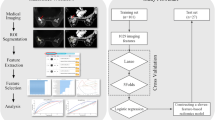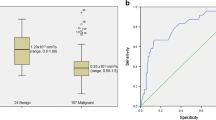Abstract
Objectives
To investigate the value of the whole-lesion histogram apparent diffusion coefficient (ADC) metrics for differentiating low-risk from non-low-risk ductal carcinoma in situ (DCIS).
Methods
The authors identified 93 women with pure DCIS who had undergone preoperative MR imaging and diffusion-weighted imaging from 2013 to 2016. Histogram analysis of pixel-based ADC data of the whole tumour volume was performed by two radiologists using a software tool. The results were compared between low-risk and non-low-risk DCIS. Associations between quantitative ADC metrics and low-risk DCIS were evaluated by receiver operating characteristics (ROC) curve and logistic regression analyses.
Results
In whole-lesion histogram analysis, mean ADC and 5th, 50th and 95th percentiles of ADC were significantly different between low-risk and non-low-risk DCIS (1.522, 1.207, 1.536 and 1.854 × 10−3 mm2/s versus 1.270, 0.917, 1.261 and 1.657 × 10−3 mm2/s, respectively; p = .004, p = .003, p = .004 and p = .024, respectively). ROC curve analysis for differentiating low-risk DCIS revealed that 5th percentile ADC yielded the largest area under the curve (0.786) among the metrics of whole-lesion histogram, and the optimal cut-off point was 1.078 × 10−3 mm2/s (sensitivity 80%, specificity 75.9%, p = .001). Multivariate regression analysis revealed that a high 5th percentile of ADC (> 1.078× 10−3 mm2/s; odds ratio [OR] = 10.494, p = .016), small tumour size (≤ 2 cm; OR = 12.692, p = .008) and low Ki-67 status (< 14%; OR = 10.879, p = .046) were significantly associated with low-risk DCIS.
Conclusions
Assessment with whole-lesion histogram analysis of the ADC could be helpful for identifying patients with low-risk DCIS.
Key Points
• Whole-lesion histogram ADC metrics could be helpful for differentiating low-risk from non-low-risk DCIS.
• A high 5th percentile ADC was a significant factor associated with low-risk DCIS.
• Risk stratification of DCIS is important for their management.


Similar content being viewed by others
Abbreviations
- ADC:
-
Apparent diffusion coefficient
- AUC:
-
Area under the curve
- CI:
-
Confidence interval
- DCIS:
-
Ductal carcinoma in situ
- DWI:
-
Diffusion-weighted imaging
- ER:
-
Oestrogen receptor
- HER2:
-
Human epidermal growth factor receptor 2
- ICC:
-
Intraclass correlation coefficient
- OR:
-
Odds ratio
- PR:
-
Progesterone receptor
- ROC:
-
Receiver operating characteristic
- ROI:
-
Regions of interest
References
Lippman M (2002) Why study ductal carcinoma in situ. In: Silverstein MJ, Recht A, Lagios MD (eds) Ductal carcinoma in situ of the breast, 2nd edn. Lippincott William and Wilkins, Philadelphia, pp 12–16
Sanders ME, Schuyler PA, Dupont WD, Page DL (2005) The natural history of low-grade ductal carcinoma in situ of the breast in women treated by biopsy only revealed over 30 years of long-term follow-up. Cancer 103:2481–2484
Page DL, Dupont WD, Rogers LW, Landenberger M (1982) Intraductal carcinoma of the breast: Follow-up after biopsy only. Cancer 49:751–758
Page DL, Dupont WD, Rogers LW, Jensen RA, Schuyler PA (1995) Continued local recurrence of carcinoma 15–25 years after a diagnosis of low grade ductal carcinoma in situ of the breast treated only by biopsy. Cancer 76:1197–1200
Sagara Y, Mallory MA, Wong S et al (2015) Survival benefit of breast surgery for low-grade ductal carcinoma in situ: a population-based cohort study. JAMA surg 150:739–745
Marini C, Iacconi C, Giannelli M, Cilotti A, Moretti M, Bartolozzi C (2007) Quantitative diffusion-weighted MR imaging in the differential diagnosis of breast lesion. Eur Radiol 17:2646–2655
Guo Y, Cai Y, Cai Z et al (2002) Differentiation of clinically benign and malignant breast lesions using diffusion-weighted imaging. J Magn Reson Imaging 16:172–178
Iima M, Le Bihan D, Okumura R et al (2011) Apparent diffusion coefficient as an MR imaging biomarker of low-risk ductal carcinoma in situ: a pilot study. Radiology 260:364–372
Rahbar H, Partridge SC, Eby PR et al (2011) Characterisation of ductal carcinoma in situ on diffusion weighted breast MRI. Eur Radiol 21:2011–2019
Rahbar H, Partridge SC, DeMartini WB et al (2012) In vivo assessment of ductal carcinoma in situ grade: a model incorporating dynamic contrast-enhanced and diffusion-weighted breast MR imaging parameters. Radiology 263:374–382
Rahbar H, Parsian S, Lam DL et al (2016) Can MRI biomarkers at 3 T identify low-risk ductal carcinoma in situ? Clin Imaging 40:125–129
Hussein H, Chung C, Moshonov H, Miller N, Kulkarni SR, Scaranelo AM (2015) Evaluation of apparent diffusion coefficient to predict grade, microinvasion, and invasion in ductal carcinoma in situ of the breast. Acad Radiol 22:1483–1488
Just N (2014) Improving tumour heterogeneity MRI assessment with histograms. Br J Cancer 111:2205–2213
Silverstein MJ, Poller DN, Waisman JR et al (1995) Prognostic classification of breast ductal carcinoma-in-situ. Lancet 345:1154–1157
Allred DC, Harvey JM, Berardo M, Clark GM (1998) Prognostic and predictive factors in breast cancer by immunohistochemical analysis. Mod Pathol 11:155–168
Moeder CB, Giltnane JM, Harigopal M et al (2007) Quantitative justification of the change from 10% to 30% for human epidermal growth factor receptor 2 scoring in the American Society of Clinical Oncology/College of American Pathologists guidelines: tumor heterogeneity in breast cancer and its implications for tissue microarray–based assessment of outcome. J Clin Oncol 25:5418–5425
Landis JR, Koch GG (1977) The measurement of observer agreement for categorical data. Biometrics 33:159–174
Virnig BA, Tuttle TM, Shamliyan T, Kane RL (2010) Ductal carcinoma in situ of the breast: a systematic review of incidence, treatment, and outcomes. J Natl Cancer Inst 102:170–178
Ernster VL, Ballard-Barbash R, Barlow WE et al (2002) Detection of ductal carcinoma in situ in women undergoing screening mammography. J Natl Cancer Inst 94:1546–1554
Bickel H, Pinker K, Polanec S et al (2017) Diffusion-weighted imaging of breast lesions: region-of-interest placement and different ADC parameters influence apparent diffusion coefficient values. Eur Radiol 27:1883–1892
Partridge SC, Mullins CD, Kurland BF et al (2010) Apparent diffusion coefficient values for discriminating benign and malignant breast MRI lesions: effects of lesion type and size. AJR Am J Roentgenol 194:1664–1673
Kul S, Eyuboglu I, Cansu A, Alhan E (2014) Diagnostic efficacy of the diffusion weighted imaging in the characterisation of different types of breast lesions. J Magn Reson Imaging 40:1158–1164
Rosenkrantz AB (2013) Histogram-based apparent diffusion coefficient analysis: an emerging tool for cervical cancer characterisation? AJR Am J Roentgenol 200:311–313
Kim EJ, Kim SH, Park GE et al (2015) Histogram analysis of apparent diffusion coefficient at 3.0 T: correlation with prognostic factors and subtypes of invasive ductal carcinoma. J Magn Reson Imaging 42:1666–1678
Mori N, Ota H, Mugikura S et al (2015) Luminal-type breast cancer: correlation of apparent diffusion coefficients with the Ki-67 labeling index. Radiology 274:66–73
Choi Y, Kim SH, Youn IK et al (2017) Rim sign and histogram analysis of apparent diffusion coefficient values on diffusion-weighted MRI in triple-negative breast cancer: Comparison with ER-positive subtype. PLoS One 12:e0177903
Jansen SA, Newstead GM, Abe H, Shimauchi A, Schmidt RA, Karczmar GS (2007) Pure ductal carcinoma in situ: kinetic and morphologic MR characteristics compared with mammographic appearance and nuclear grade. Radiology 245:684–691
Kwee RM, Dik AK, Sosef MN et al (2014) Interobserver reproducibility of diffusion-weighted MRI in monitoring tumor response to neoadjuvant therapy in esophageal cancer. PLoS One 9:e92211
Suo S, Zhang K, Cao M et al (2016) Characterisation of breast masses as benign or malignant at 3.0 T MRI with whole-lesion histogram analysis of the apparent diffusion coefficient. J Magn Reson Imaging 43:894–902
Hirano M, Satake H, Ishigaki S, Ikeda M, Kawai H, Naganawa S (2012) Diffusion-weighted imaging of breast masses: comparison of diagnostic performance using various apparent diffusion coefficient parameters. AJR Am J Roentgenol 198:717–722
Matsumoto Y, Kuroda M, Matsuya R et al (2009) In vitro experimental study of the relationship between the apparent diffusion coefficient and changes in cellularity and cell morphology. Oncol Rep 22:641–648
Kuerer HM (2011) Rational individualised selection of adjuvant therapy for ductal carcinoma in situ. Lancet Oncol 12:2–3
Rutter CE, Park HS, Killelea BK, Evans SB (2015) Growing use of mastectomy for ductal carcinoma-in situ of the breast among young women in the United States. Ann Surg Oncol 22:2378–2386
Kim J, Son EJ, Youk JH et al (2011) MRI findings of pure ductal carcinoma in situ: kinetic characteristics compared according to lesion type and histopathologic factors. AJR Am J Roentgenol 196:1450–1456
Chan S, Chen JH, Agrawal G et al (2010) Characterisation of pure ductal carcinoma in situ on dynamic contrast-enhanced MR imaging: do nonhigh grade and high grade show different imaging features? J Oncol. https://doi.org/10.1155/2010/431341
Acknowledgements
This work was based on the Multi Parametric Analysis works-in-progress software package provided by Siemens Healthineers.
This study was presented at the 2017 RSNA Scientific Assembly.
Funding
The authors state that this work has not received any funding.
Author information
Authors and Affiliations
Corresponding author
Ethics declarations
Guarantor
The scientific guarantor of this publication is Jin You Kim.
Conflict of interest
The authors of this manuscript declare no relationships with any companies whose products or services may be related to the subject matter of the article.
Statistics and biometry
No complex statistical methods were necessary for this paper.
Informed consent
Written informed consent was waived by the institutional review board.
Ethical approval
Institutional review board approval was obtained.
Methodology
• retrospective
• observational
• performed at one institution
Rights and permissions
About this article
Cite this article
Kim, J.Y., Kim, J.J., Lee, J.W. et al. Risk stratification of ductal carcinoma in situ using whole-lesion histogram analysis of the apparent diffusion coefficient. Eur Radiol 29, 485–493 (2019). https://doi.org/10.1007/s00330-018-5666-x
Received:
Revised:
Accepted:
Published:
Issue Date:
DOI: https://doi.org/10.1007/s00330-018-5666-x




